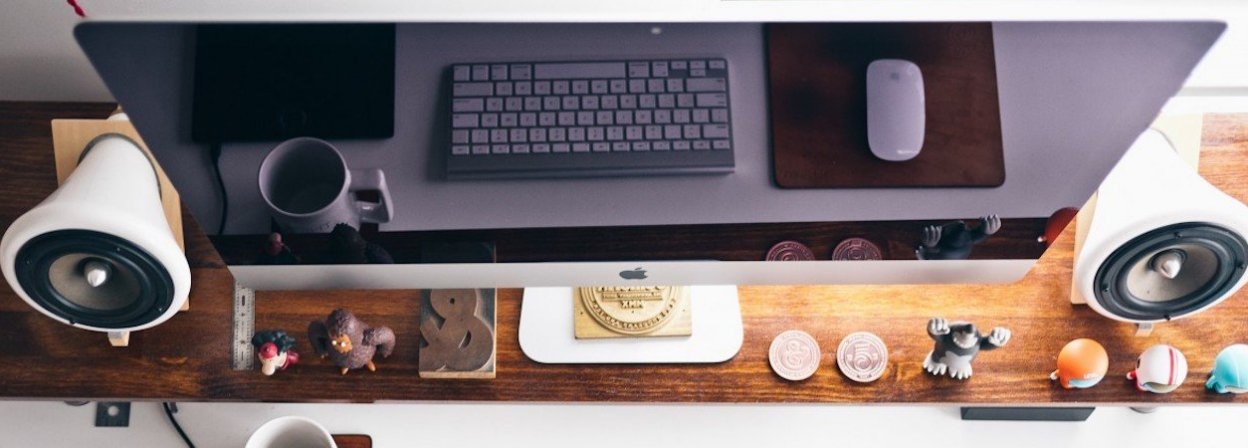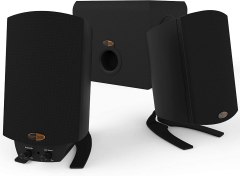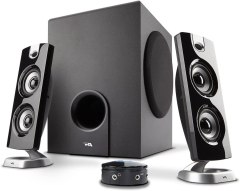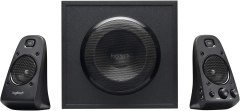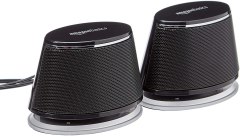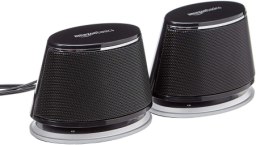Buying guide for Best desktop speakers
When you’re looking for a great audio system to round out your new PC tower build, or you need better sound quality than the built-in speakers in your laptop can provide, desktop speakers fit the bill. The desktop speaker is perennially popular, and more options are available than ever before.
That can make choosing a desktop speaker a little more difficult. Can you find a surround sound experience only in speakers at the top of the heap? Are budget speakers worth the investment? There are plenty of other factors to consider too, from color and shape to wired or wireless.
Key considerations
PC speakers vs. desktop speakers
First, a terminology lesson. A desktop speaker is completely different from a PC speaker.
PC: The PC speaker is typically mounted on the motherboard and is the thing that makes loud beeps when something isn’t right with the computer.
Desktop: These speakers are designed specifically to work with computers and laptops, with no converter or adapter needed. Simply plug them into the corresponding port (either the 3.5-millimeter audio port or the USB port, depending on the connector at the end of the cable) and the computer’s built-in audio driver does the rest. In some cases, you may need to install additional drivers provided by the manufacturer so that the desktop speakers work with the computer. In general, though, desktop speakers are painless to set up: you just plug them in and play your favorite audio tracks or game.
Form
For decades, desktop speakers, also called computer or multimedia speakers, mostly had a familiar form factor: two main cabinets with at least one speaker apiece, designed to stand upright on either side of a computer monitor. A square or rectangular subwoofer might be part of the set, providing a bass boost to the sound setup.
Those boxy setups are no longer the only option for desktop speakers. Cabinet designs include flowing, wavy shapes, futuristic domes, interior or exterior LED lighting, and streamlined, slim looks, as well as a range of colors. Speakers can now mount on poles near, on top of, or far from your desk. They can stand near the monitor, on a shelf, or in any other configuration that will give you the best sound setup.
Function
As you shop, consider the control options in a desktop speaker system. Some speakers stay on all the time as long as they’re plugged in, while others can be independently switched on and off. Some are completely analog, requiring you to manually adjust the audio level with the volume dial. Some include an app or software that you can use to fine-tune the audio experience through your computer.
Wireless vs. wired
You’ll also want to think about whether you want wired or wireless speakers.
Wireless: If you want to set up speakers several feet from your desk, or you just don’t like lots of wires cluttering things up, wireless speakers are a good choice.
If you plan to frequently connect desktop speakers to multiple devices, Bluetooth is a great option, and it’s increasingly standard for desktop speakers. You can quickly switch audio sources from computer to smartphone to another device as needed.
Wired: If you don’t have a lot of room to work with or just want a traditional front-facing desktop speaker configuration, wired speakers work just fine and can offer some savings.
Sound
No one wants a tinny, thin sound when they’re listening to music, watching videos, or gaming. That’s something desktop speakers can solve. Even budget-priced desktop speakers can provide decent sound compared to many built-in laptop speakers. But if you want to get optimal sound for your budget, consider some additional factors.
Environment: A desktop speaker that sounds fantastic in a store showroom may disappoint when used in a small room with carpet and lots of furniture. If you’re stereo shopping in person, use the store’s demo room, which is configured for a typical home environment. If you’re shopping online, make sure you can return or exchange the desktop speaker before purchasing in case you’re not happy with the sound. Set up the speakers as soon as they arrive so you can decide if they’re going to work for you.
Channels: In a stereo or surround sound system, audio is decoded and assigned to channels, which then send the sound through an amplifier and corresponding speakers. Two-channel stereo (2.0) is quite common in desktop speakers. Add a subwoofer for a 2.1-channel configuration. This also allows for a degree of virtual surround sound using digital codecs and sound-processing technologies. Higher-end, “true” surround sound setups have more channels and corresponding speakers, commonly 5.1 or 7.1 channels. Separate, dedicated bass and volume controls will allow you to quickly adjust speaker and woofer output.
Technology: You’ll see the following brand names bandied around when researching speaker sound quality. Here is what they mean.
- Dolby: This popular codec is used by content creators to encode sound efficiently and decode it for optimal playback. An audio source (such as a track provided by an online music streaming service) might be recorded digitally using Dolby to encode it. Your Dolby-compatible audio system can then decode it and play it through the desktop speakers.
- DTS: This is a codec that, like Dolby, is used for encoding and decoding digital audio. It is also widely used and compatible with most desktop speakers.
- THX: This is a sound-processing technology that augments decoded audio. In some audio systems, you can add a level of THX sound augmentation, such as listening mode or surround sound, in conjunction with Dolby or DTS.
To optimize sound quality from desktop speakers, make sure there are a few inches of clear space around each speaker cabinet. Clutter can muffle audio playback.
STAFF
BestReviews
Features
Here are some additional things to consider before making a purchase:
Brand
Top-rated speaker manufacturers like Bose and Harman Kardon have earned their reputations, but don’t overlook quality competitors including Logitech.
Inputs
Look for multiple audio inputs. Think about the different ways you listen to audio, such as through headphones or via connecting other devices like your smartphone and make sure your desktop speakers can accommodate them.
Versatility
Multi-device compatibility: Maybe you want a surround sound experience not just at your computer but also when watching TV or gaming on your phone. If so, look for a system that can connect to other devices either through Bluetooth, WiFi, or a wired connection.
Adaptability: If you like to configure your sound system or add components, a desktop speaker that can connect to other speakers is a good option.
Portability: Being able to quickly pack and unpack your sound system is ideal for college students or those who move frequently.
DID YOU KNOW?
What do 2.0, 2.1, and 5.1 mean? The first number is the number of speakers. The second number is the subwoofer unit. For example, a 2.0 configuration is a basic stereo with two speakers and no subwoofer.
STAFF
BestReviews
Accessories
Speaker isolation pads: Sound Addicted Speaker Monitor Isolation Pads
Reduce speaker vibration and unwanted resonance with pads like this high-density pair from Sound Addicted and improve your overall listening experience.
Speaker stands: Sanus Adjustable Height Speaker Stands
Optimize your sound experience by removing the possibility of vibration interference. A must-have for 5.1 and 7.1-channel surround setups. These stands adjust from 28 to 38 inches.
Speaker shelf brackets: VideoSecu Side Clamping Speaker Mounting Brackets
Expand your listening space even in a small room by placing desktop speakers on these adjustable brackets that clamp quickly to the desk or a bookshelf. They swivel and tilt and support up to 33 pounds.
Adapter cable: Cmple 3.5 mm Male Stereo to 2 Male RCA Audio Adapter
Occasionally, the included cables in a stereo system don’t match up with the available ports on a computer. Adapters like this 6-foot cable are available in a variety of configurations to solve this.
DAC: Prozor 192 KHz Digital to Analog Audio Converter
An external DAC can really fine-tune the audio experience and boost performance of high-end speakers. This one from Prozor is easy to set up and simple to use.
Desktop speaker prices
You should notice a drastic difference between inexpensive speakers and pricey speakers, but you don’t need to shell out top dollar to get really good sound.
Inexpensive
For those on a tight budget or who want better sound or some basic bass tones, 2.0 and 2.1 channel desktop speakers are available in a range of cabinet designs from $19 to $89.
Mid-range
Larger cabinets, more features like surround sound, and speakers able to handle more volume all define the mid-range price point of $90 to $295.
Expensive
Top-quality speakers that feature center-channel soundbars and sound-isolating cabinets are a hallmark of the highest price range of $299 to $489.
Take advantage of included software to equalize audio output after positioning the speakers. Or you can use your computer’s advanced audio settings to get the best sound.
STAFF
BestReviews
Tips
- Check the manual for advice on placement. You can then make adjustments as needed. This will give you the best sound experience. If you have a subwoofer, place it between the left and right speakers for optimal sound. Many opt to place it lower or higher than the speakers to avoid interference and keep the desktop clear.
- Use speaker pads. Consider placing desktop speakers on sound-dampening isolation pads to reduce vibration and redirect sound forward rather than downward.
- Try raising the speakers. Raising speakers from the desktop by a few inches can help clarify sound even further. Consider using desktop speaker stands or placing them on a raised monitor stand or shelf.
- Use a game’s suggested settings. Computer games often include audio adjustment settings to optimize speaker output. Be sure to use the option if it’s available.
- Level and stabilize your desk or speaker stand. A wobbly desk or speaker stand can drastically affect sound quality.
FAQ
Q. I have a 5.1 desktop speaker system. What is the ideal placement for each speaker?
A. Your system includes three main (front) speakers and two satellite speakers, as well as a subwoofer. The recommended placement is to set up one speaker in the center (you might need to mount this higher than the desktop to clear obstacles like the monitor), one to the left and one to the right. The subwoofer can be placed between the left and right speakers. It’s often placed on the floor or mounted on a low stand. The satellite speakers should be placed to your left and right, a few degrees behind each shoulder and level with or slightly above your head when seated. Set up this configuration to start with, then test it and make adjustments so the speaker placement works for you and you get the best surround sound experience.
Q. My left speaker volume can only go up a little bit before it’s overwhelmed by static. What’s going on?
A. You have either a faulty cable or a faulty speaker. In budget-priced desktop speakers, the cables are often permanently attached to the speakers and can’t be easily or cheaply removed. Usually, the entire speaker system must be replaced. You might be able to replace the cables in a higher-end system. If that doesn’t fix the problem, the speaker may be blown out and must be replaced. Speakers at all price levels have a finite lifespan. If you’ve had a desktop speaker system for several years and there’s a lot of noise in playback, it’s probably time to shop for a new one. If a brand-new speaker is behaving badly, take advantage of the return policy or warranty and exchange or replace the unit.
Q. I set up new desktop speakers and plugged them into my computer, but no sound is coming out. What’s going on?
A. Pull out the troubleshooting manual offered by the manufacturer and try the steps it suggests. If there is no manual, start with basic steps and work your way up.
- Make sure the desktop speaker is plugged into a power source (some are powered through the PC, while others must be plugged into an outlet) and that it’s powered on.
- Reboot your computer.
- If there’s still no sound, open the audio settings provided by your computer’s operating system and select the troubleshooting option. Follow the recommended steps.
- If none of this works, check the manufacturer’s website for troubleshooting instructions or contact information. You may also find useful advice on audio forums from other users who have experienced the same problem.

